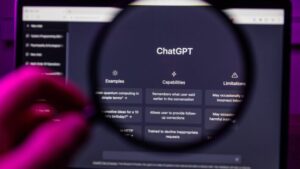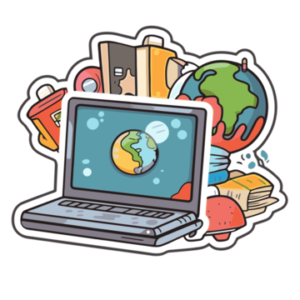I will come right out and say it – I LOVE AI. I have strongly advocated for AI in education since the first day Chat GTP was introduced to the world. So… this made this week’s debate REALLY hard for me. Despite my feelings, I pushed forward and dare I say I am slightly more suspicious of AI now.

AI is here, and it is here to stay. And because of this, I never once stopped to consider the negative aspects associated with it. Admittedly I didn’t think there could be any. Who would ever argue against something that is going to make life easier (see what I did there?). So I was surprised when I found article after article exploring the darker side of AI technology.
One reoccurring concern was the dehumanization of education. Education, of course, is about learning. However, at a much deeper level, education is about connection. A teacher’s job goes far beyond a whiteboard. Student-teacher relationships are the foundation of the education system. A robot, or in this case GenerativeAI, cannot help this. As noted by ClassPoint, “With AI algorithms generating content and deciding the pacing of the lessons, students may miss out on the nuanced approach that a human teacher can offer. Additionally, AI algorithms can perpetuate bias, meaning that they may fail to provide an inclusive and diverse curriculum that is tailored to the needs of every student”.
It was noted during the debate that GenreativeAI systems like Chat GTP can be used to provide instant feedback. And while it can, I don’t think it should and this comes from personal experience. During the previous school year, I tried to use AI to generate comments for a lengthy summer reading assignment that my advanced English Language Arts 20 class had to complete. At first, I was sold, my marking time was practically cut in half. I handed back the assignments and went off into quiet teacher bliss. Or so I thought. It didn’t take long for students to start asking for better comments or specifics on what they did wrong. And then before I could even catch my breath – “Mazur you used AI didn’t you?”. I had been caught. This situation taught me one thing – Chat GTP made my job much easier in the moment, but it didn’t replace the “human touch”. After much reflection, I decided it would have been easier, and much less stressful, to have written personalized comments for all 67 of my students. But maybe I am using the wrong application here! Someone enlighten me, please! I am begging you.
One thing that surprised me the most during my research was the inaccuracy of AI information. I always thought AI knew it all including current events. This isn’t even remotely true. Chat GTP and other similar GenerativeAI systems have a “knowledge cutoff” date. The argument could be made that other educational resources like textbooks have similar cutoff dates. However, I would argue that we are aware that a textbook published in 2019 wouldn’t contain information about the 2020 COVID-19 Pandemic. But, myself included, would have assumed that GenerativeAI systems like Chat GTP would be up to date with current information. Something to consider nevertheless.
But alas, am I convinced AI is ruining education? No, I’m not. Maybe I’m not supposed to admit that since I was on the disagreeing side? Several positive aspects of AI were noted during this week’s debate. First and foremost, of course, is the fact that AI is making our job easier. AI revolutionizes the way we plan, assess, and communicate. According to the World Economic Forum, AI can:
- support education by automating administrative tasks, freeing teachers to focus more on teaching and personalized interactions with students, enhancing rather than replacing human-led teaching.
- improve digital literacy, critical thinking, problem-solving and creativity, preparing learners for future job demands.
- tailor the learning experience to the individual, enhancing academic performance while seamlessly catering to diverse learning needs.
It was also noted that AI technologies can be used to support students of varying needs. And who wouldn’t want this? But I would be cautious to say that AI helps educators support ALL students better. It would be remiss to not acknowledge the digital divide that exists globally.
As I mentioned earlier, I kind of like AI. Okay, I love AI. I use it for everything from rubric-making to reference letter writing. I have seen firsthand all the ways AI has made my job easier. I also use AI to help support my students better by using the following applications:
- Grammarly: Grammarly is the AI writing partner that helps people at every stage of the writing process, from blank page to final draft.
- HelloHistory: Engage students with interactive AI-driven dialogues and role-play activities that offer first-person perspectives and debates on historical events
- Parlay: Parlay is an AI-powered instructional platform that helps teachers facilitate meaningful, measurable, and inclusive class discussions.
Looking back on this process, I am surprised to find that my perspective has changed. Will I stop using AI? No, I won’t. But will I be more aware of the gambit of issues that this type of technology will present? 100 percent I will. New ammo for that first staff meeting back in August! So, yes I will keep using AI for now and I’ll hope and pray that one day I am not fired in favour of the newest model of AI robot.
